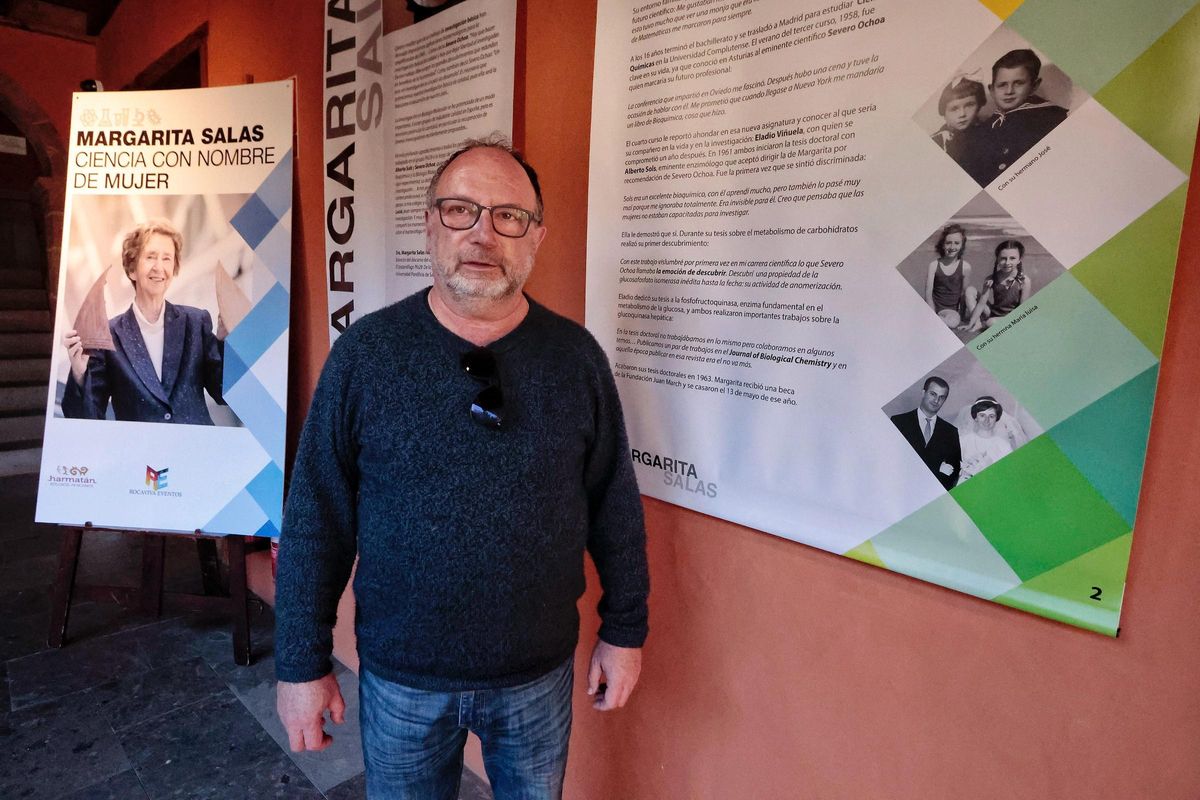Laura carefully and curiously contemplates the twelve panels that appear at the entrance of the beautiful inner courtyard of the Adrián Alemán de Armas Municipal Library in La Laguna, at number 9 Juan de Vera street. A high school student at a well-known institute in Aguere, she is the perfect visitor for the exhibition that piques her interest, one that highlights the life and career of perhaps the most brilliant Spanish scientist in history: biochemist Margarita Salas (1938-2019). One of the main objectives of the exhibition is to attract girls who are about to start their higher education studies or are already in university. If they are from La Laguna, great, and if their interest is in STEM careers – Science, Technology, Engineering, and Mathematics – fantastic, but it is free and open to all.
Laura is spot on with her interest in Salas’ figure, thanks to the Social Welfare department of the City Council, who is driving the initiative, the organizers at Rocaviva Events, and collaborators, the Pontifical University of Salamanca and the Scientific Culture Unit of the i+12 Research Institute at the 12 de octubre University Hospital in Madrid.
EL DÍA explores the exhibition, framed within the events of March 8th and open until the 27th, with the curator, Ángel Quintero. He details Margarita Salas’ scientific and social achievements based on her own quotes and those spoken by others whose images are included on the panels, such as her first scholarship recipient, Jesús Ávila, still active at 78, or the legendary Albert Einstein who encapsulates what Salas’ figure and influence might represent: “Leading by example is not a way to influence others; it is the only way.”

Exhibition about the scientist Margarita Salas in La Laguna. / María Pisaca
A very original way to explain the historical importance of this disciple of the eminent Severo Ochoa at the Complutense University of Madrid who was just short of receiving the Nobel Prize. Accompanied by Quintero is a highly interested Laura who, from time to time, interjects the conversation with her insightful questions about the person and her work.
Salas’ quotes reflect her personality, scientific vocation, and commitment to her gender. Firstly, “for me, researching is a passion; I couldn’t live without research.” She dedicated her entire life to it. Another declaration that is now remembered is: “Women are not going to arrive, they are already here,” Laura confirms. But she also expressed her views on some crucial aspects. Once again with a powerful statement: “I don’t like quotas. All positive discrimination always implies negative discrimination for someone.”
An example of unwavering vocation is her idea of “dying with her lab coat on.” She was very clear about the value of work: “A scientific vocation is not born, it is made.” Or when she states: “I was never an extraordinary talent, but a tireless worker.”
The Social Welfare councillor of La Laguna, María Cruz, also visited the Science with a Woman’s Name exhibition alongside the Presidency councillor, Carla Cabrera. Cruz highlighted about Salas that “in addition to being a prominent figure in science, she was also a pioneer in joining prestigious institutions such as the Royal Academies of Sciences or Spanish.” An elaborate way to “open the doors for women who extended her legacy.”
Margarita Salas made significant discoveries, among which stands out the DNA polymerase enzyme of the Phi.29 bacteriophage, which allows genetic material to be replicated from tiny amounts. This achievement has had significant biotechnological applications in fields such as archaeology, forensic medicine, or criminology. Her patent has been the most profitable in the history of the Spanish National Research Council (CSIC). Throughout her life, she joined other prestigious institutions such as the National Academy of Sciences of the United States and went on to preside over the Institute of Spain. She also received prominent awards from the European Patent Office shortly before her death in 2019.
Global Reference
Salas became a global reference for her research, but also for her social commitment and gender equality in her professional field. An example of effort, teamwork, dedication to scientific dissemination, and fostering vocations. Like the one that seems to have awakened in Laura.
The technical specifications of this free exhibition, which can be visited from 9:00 to 21:00, Monday to Friday, cannot be missed. It consists of twelve didactic panels measuring 100×170 centimeters. Ten of them review the life and professional trajectory as a researcher and educator of the honoree, the entrance panel displays the logos of the participating entities, and the other is dedicated to clinical trials. A selfie corner with silhouettes of scientists and a five-minute audiovisual dedicated to the protagonist complete the charming installation in an ideal setting.
In La Laguna, until the end of the month, science bears a woman’s name. Flipping the title of a Spanish film during the Franco era would result in something like this: science is called Margarita.















